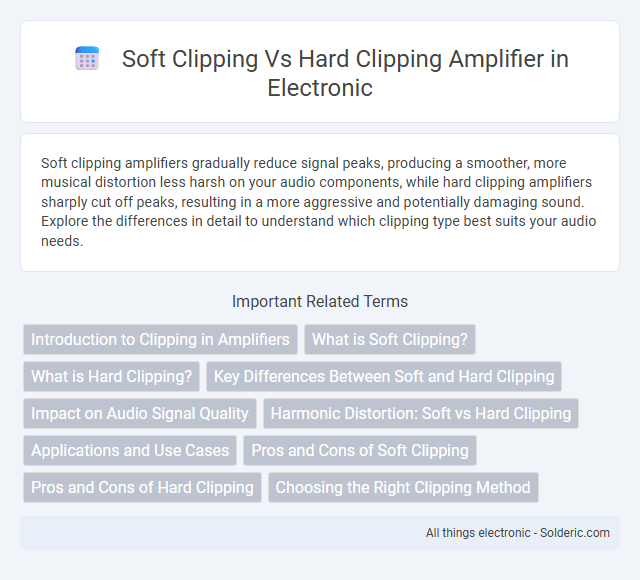Soft clipping amplifiers gradually reduce signal peaks, producing a smoother, more musical distortion less harsh on your audio components, while hard clipping amplifiers sharply cut off peaks, resulting in a more aggressive and potentially damaging sound. Explore the differences in detail to understand which clipping type best suits your audio needs.
Comparison Table
| Feature | Soft Clipping Amplifier | Hard Clipping Amplifier |
|---|---|---|
| Clipping Type | Gradual distortion with rounded waveform peaks | Abrupt cutoff of waveform peaks |
| Distortion Characteristic | Smoother, warm, and musical distortion | Harsh, aggressive, and gritty distortion |
| Signal Harmonics | Predominantly even-order harmonics | Primarily odd-order harmonics |
| Dynamic Range Impact | Preserves more dynamics and headroom | Reduces dynamic range significantly |
| Usage | Blues, jazz, smooth overdrive effects | Rock, metal, aggressive distortion effects |
| Sound Texture | Warm, creamy, less harsh | Edgy, buzzy, more pronounced clipping |
| Typical Circuit Components | Diodes with soft knee characteristics (e.g., LED, germanium) | Diodes with hard cutoff (e.g., silicon diodes) |
Introduction to Clipping in Amplifiers
Clipping in amplifiers occurs when the output signal exceeds the maximum voltage the device can handle, causing distortion. Soft clipping rounds off the waveform peaks, producing a smoother, more musical distortion favored in guitar amplifiers. Hard clipping sharply truncates the waveform, resulting in a harsher, more aggressive distortion commonly used in high-gain amplifiers and effects pedals.
What is Soft Clipping?
Soft clipping in amplifiers refers to the gradual transition from clean signal to distortion as the input signal exceeds the amplifier's linear operating range, resulting in rounded waveform peaks and less harsh harmonic distortion. This effect preserves more of the original audio signal's character by avoiding abrupt waveform clipping, producing a warmer and more musical sound compared to hard clipping. Soft clipping is commonly used in guitar amplifiers and audio processing to achieve natural overdrive and reduce unwanted noise artifacts.
What is Hard Clipping?
Hard clipping is a form of signal distortion where the amplifier abruptly cuts off the waveform once it exceeds a certain threshold, creating a sharp, flat-topped waveform. This results in a harsher, more aggressive sound with increased harmonic distortion and potential digital-like artifacts. Your audio may lose clarity and exhibit noticeable compression, making hard clipping favored for aggressive guitar tones but unsuitable for clean or dynamic audio.
Key Differences Between Soft and Hard Clipping
Soft clipping amplifiers gradually compress audio signals as they approach the clipping threshold, producing warmer, more musical distortion by gently rounding wave peaks. Hard clipping amplifiers abruptly cut off signal peaks at a set level, creating harsher, more aggressive distortion with sharp waveform edges. Understanding these key differences helps you choose the right amplifier type for your desired sound character and application.
Impact on Audio Signal Quality
Soft clipping amplifiers gradually compress the audio signal as it approaches the clipping threshold, preserving harmonic content and resulting in a warmer, more natural sound with fewer harsh distortions. Hard clipping amplifiers abruptly cut off the signal once the threshold is exceeded, producing sharp, aggressive distortion that can introduce unwanted high-frequency artifacts and reduce overall audio fidelity. The choice between soft and hard clipping significantly affects audio signal quality, with soft clipping favoring musicality and hard clipping emphasizing intensity and edge.
Harmonic Distortion: Soft vs Hard Clipping
Soft clipping amplifiers produce harmonic distortion with smoother, rounded waveforms, primarily generating even-order harmonics that are musically pleasing and less harsh to the ear. Hard clipping amplifiers create sharp waveform truncations, resulting in higher levels of odd-order harmonics that can sound aggressive and cause more audio harshness or listener fatigue. Understanding these differences in harmonic distortion helps you choose the right amplifier type for desired tonal warmth or aggressive punch in your audio setup.
Applications and Use Cases
Soft clipping amplifiers are preferred in audio applications where preserving signal integrity and reducing harsh distortion is crucial, such as in guitar effects pedals and hi-fi audio equipment. Hard clipping amplifiers find use in applications requiring aggressive distortion and strong signal limiting, including certain types of electric guitar distortion pedals and radio transmitters to prevent signal overload. Choosing between soft and hard clipping depends on the desired tonal characteristics and the specific use case within audio processing or signal conditioning environments.
Pros and Cons of Soft Clipping
Soft clipping in amplifiers offers the advantage of smoother distortion, reducing harshness and protecting speaker components from sudden signal peaks. It produces warmer, more musical overdrive that is preferred in audio applications requiring natural sound compression. However, soft clipping can introduce slight signal compression and less aggressive gain, which may lack the intensity desired in some high-gain scenarios.
Pros and Cons of Hard Clipping
Hard clipping amplifiers create a distinctive, aggressive distortion by sharply cutting off signal peaks, ideal for producing a raw, vintage rock tone. Their pros include a strong, punchy sound with high sustain, making them popular for heavy metal and punk styles; however, the harsh distortion can introduce undesirable harshness and increase harmonic noise. You should consider that hard clipping risks speaker damage if overdriven excessively due to its abrupt waveform clipping, unlike softer, more transparent distortion types.
Choosing the Right Clipping Method
Choosing the right clipping method depends on the desired tonal characteristics and amplifier behavior: soft clipping produces smoother, warmer distortion by gradually compressing the signal, ideal for blues and classic rock tones, while hard clipping abruptly cuts wave peaks, creating harsher, more aggressive distortion suited for heavier genres like metal. Soft clipping amplifiers often use analog components like diodes or vacuum tubes to gently limit output, preserving dynamics and musicality, whereas hard clipping circuits rely on transistor saturation or digital clipping techniques to achieve more pronounced cutoff. Understanding the specific sound profile and genre requirements helps guitarists and audio engineers select between soft and hard clipping for optimal performance and sonic expression.
soft clipping vs hard clipping amplifier Infographic

 solderic.com
solderic.com